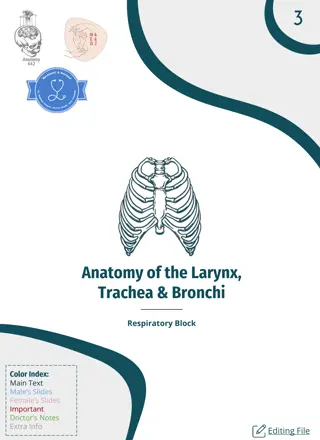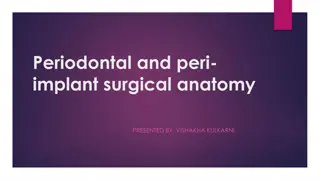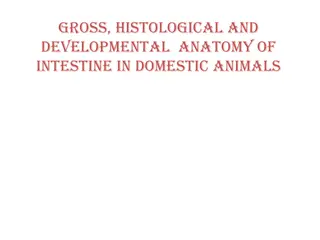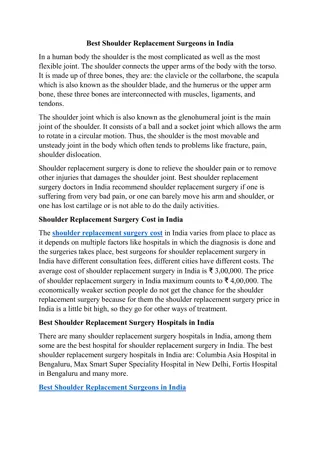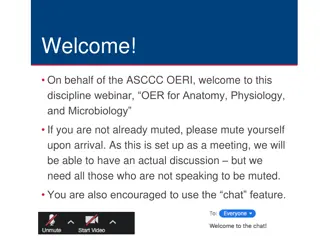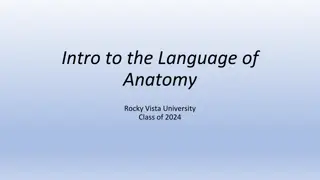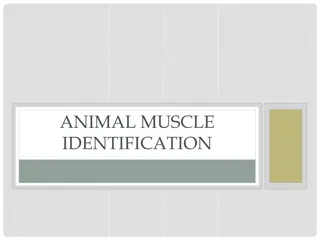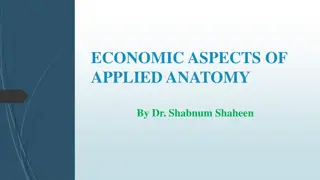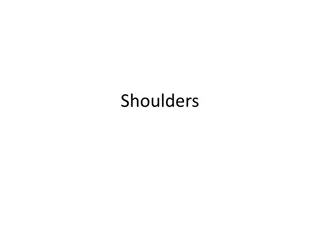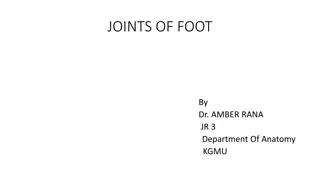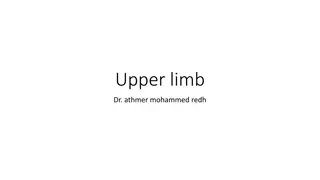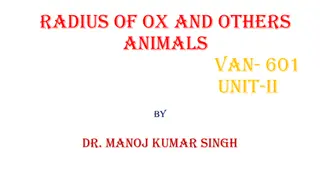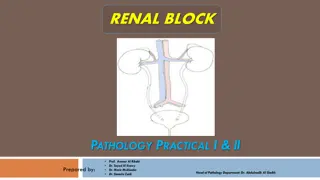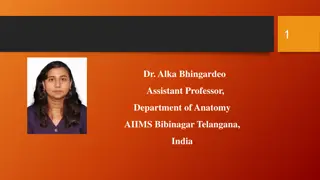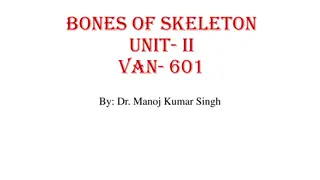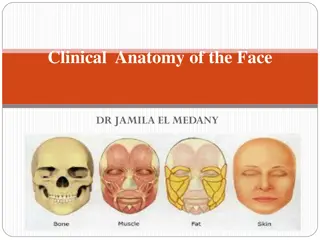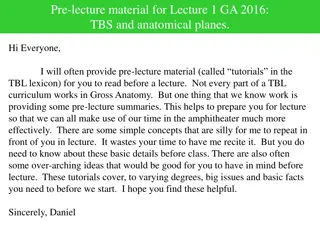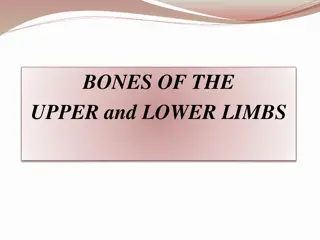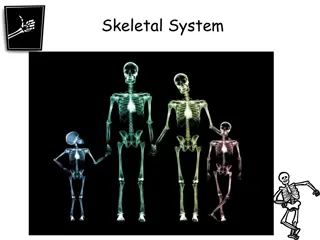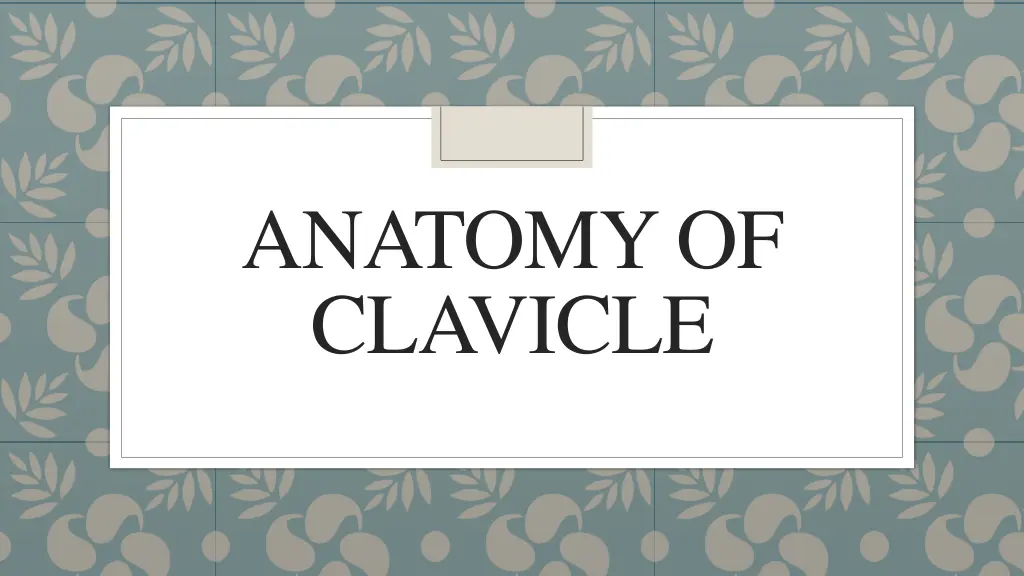
Understanding the Anatomy of Clavicle
Explore the detailed anatomy of the clavicle, a long, tubular bone that transmits limb weight to the sternum. Learn about its shaft, surfaces, and lateral & medial ends, and understand its articulations with other structures.
Download Presentation

Please find below an Image/Link to download the presentation.
The content on the website is provided AS IS for your information and personal use only. It may not be sold, licensed, or shared on other websites without obtaining consent from the author. If you encounter any issues during the download, it is possible that the publisher has removed the file from their server.
You are allowed to download the files provided on this website for personal or commercial use, subject to the condition that they are used lawfully. All files are the property of their respective owners.
The content on the website is provided AS IS for your information and personal use only. It may not be sold, licensed, or shared on other websites without obtaining consent from the author.
E N D
Presentation Transcript
ANATOMY OF CLAVICLE
ANATOMY Long, Tubular and Somewhat S-shaped Bone. Transmits the Weight of The Limb to The Sternum. ImmediatelyAbove the First Rib The Bone has a Cylindrical Part Called Shaft, and Two Ends, Lateral and Medial. Articulates Medially with The Manubrium Sterni and Laterally with The Acromion of The Scapula
SHAFT Divided Into The Lateral One- Third and The Medial Two- Thirds. a) Lateral One- Third: Flattened FromAbove Downwards Has Two Borders,Anterior and Posterior. Anterior Border: Concave Thin Attachment To Deltoid Posterior Border: Convex Backwards Rough and Thick Attachment To Trapezius
Two Surfaces: Superior and Inferior Surface Superior Surface: Flat, Rough Attachment For The Deltoid In Front and Trapezius Behind Inferior Surface: Flat, Presents An Elevation Called The Conoid Tubercle (Coracoid Tuberosity) andARidge Called Trapezoid Ridge (Runs Forward and Lateralward) b) Medial Two- Thirds: Rounded and Have Four Surfaces Anterior Surface: Convex Forwards Included Between The Superior andAnterior Borders Continuous With The Superior Surface Posterior Surface: Smooth Limited above by the Superior Border; Below by The Subclavian Border; Medially by The Margins Of The Sternal Extremity and Laterally by The Coracoid Tuberoisty Concave Medio- Laterally
Superior Surface: Rough In Its Medial Part Inferior Surface: Narrow Medially Gradually Increases In Width Laterally Continuous With The Under Surface Of The Flat Portion Medial Part IsABroad Rough Surface, The Costal Tuberosity Has Longitudinal Subclavian Groove Has Three BordersAnterior, Superior and Posterior
LATERAL AND MEDIAL ENDS a. Lateral End: Small Flattened Oval Surface Directed Obliquely Downwards Bears a Facet That Articulates with the Acromion Process Of The Scapula to Form The AC Joint In Females The Clavicle is Generally Shorter, Thinner, Less Curved and Smoother Than Male
b. Medial End: Quadrangular Directed Medialward andALittle Downward and Forward Articulates With The Clavicular Notch Of The Manubrium Sterni to Form The SC Joint Articular Surface Extends To The Inferior Aspect, For Articulation With The First Costal Cartilage
ATTACHMENTS The Lateral End The Margin of The Articular Surface For The AC Joint Gives Attachment To The Joint Capsule The Medial End The Margin of The Articular Surface For The Sternum Gives Attachment To The Fibrous Capsule All Round; Articular Disc Posterosuperiorly and The Interclavicular Ligament Superiorly Lateral One- Third Of Shaft: Origin: Deltoid (Anterior Border) Insertion: Trapezius (Posterior Border) Coracoclavicular Ligament (Conoid and Trapezoid Parts)
Medial Two- Thirds: Origin: Pectoralis Major (Anterior Surface) Insertion: SCM (Superior Surface; Clavicular Head), Subclavius (Subclavian Groove) Costoclavicular Ligament: Inferior Surface; Medial End
SIDE DETERMINATION Lateral End Is Flat; Medial End Is Large and Quadrilateral Shaft Is Slightly Curved; Convex Forwards In Its Medial Two-thirds and Concave Forwards In Its Lateral One- Third Inferior Surface Is Grooved Longitudinally In Its Middle One- Third
PECULARITIES Only Long Bone That Lies Horizontally Subcutaneous Throughout First Bone To Start Ossifying Only Long Bone Which Ossifies In Membrane Only Long Bone Which Has Two Primary Centres Of Ossification Occasionally Pierced by The Middle Supraclavicular Nerve
a. Costal Tuberosity: Lies on The Medial End Inferior Surface of The Clavicle Broad, Rough Surface Anchors The Costoclavicular Ligament Strengthens The SC Joint b. Subclavian Groove: RunsAlong the Posteroinferior Quadrant of The Midshaft ProvidesAttachment For the Subclavius Muscle c. Conoid Tubercle: Lateral End of the Clavicle Posteriorly Attachment Point For The Conoid Ligament
d. Trapezoid Ridge: Leads Laterally From The Conoid Tubercle Attachment Site For The Trapezoid Ligament

